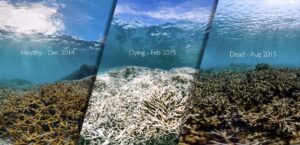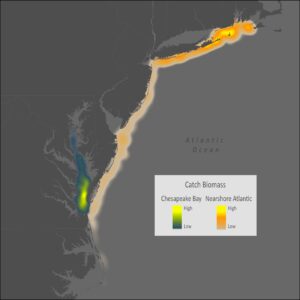Warming Waters
Introduction

Waters are warming because of increasing greenhouse gas concentrations are trapping more energy from the sun.
What are greenhouse gases? Gases in Earth’s atmosphere that trap heat such as Carbon Dioxide and Chlorofluorocarbons.
How is this affecting marine environments: variations in ocean temperature can affects what species of plants, animals, and microbes are present in location.
Warming water can alter migration and breeding patterns
Threatens sensitive ocean life such as corals, and can change intensity and frequency of harmful agal blooms
Warming Water in North Carolina
Over the Atlantic Coast, bull sharks have turned North Carolina Estuaries into a nursery, which is a sight more seen in Florida waters since Bull Sharks require water temperature 68 degrees or warmer to have their pups. In the last century average sea temperatures have risen 32 degrees Fahrenheit. Since 2008 in North Carolina Estuaries have exceeded 77 degrees Fahrenheit 60 percent of the time, allowing a perfect habitat for Bull Shark nurseries. Not only that but the salinity has increased from 4.5 to 18.3 parts per thousand in 1971 to 9 to 17.4 parts per thousand since 2011. Young Bull Sharks are found only in salinities higher than 9 parts per thousand.
One study showed that from 1965-2011 juvenile bull sharks in North Carolina Pamlico Sound were rarely ever captured when fishery-independent gillnet surveys were conducted by the North Carolina Division of Marine Fisheries. However present years 2011-2016 juvenile bull sharks have been present in these surveys every year. Bull Shark presence in the sound in related to the early summer temperatures and late summer saltines, which have increased in the estuary over the 13 survey years. These results suggest that increasing water temperature and salinity have allowed Bull Sharks to expand their nursery habitat. Although the shift will have unknown, but potentially strong, impacts on both the local ecosystem and interactions with humans.
Sharks are a highly mobile and many species are highly migratory, which makes them among the marine taxa most likely to shift distribution in response to climate change. However, species with restricted ranges or association with specific habitat areas may be more vulnerable to these warming waters.
The Lophelia Coral Banks are located off Cape Lookout, NC in water depths greater than 300m. These corals thrive in complete darkness and temperatures averaging 50 degrees Fahrenheit.
Although NC reefs are not being affected yet Steve Ross from the University of North Carolina Wilmington believes that this could change, “Tropical reefs are likely to suffer first, but cold-water coral reefs may be affected even before they are fully explored.” This is so important to understand because even though warming waters has not affected these coral it could happen and it is best to prevent it before it happens so we do not lose a very important part of our ecosystems.
Declines in water quality resulting from upstream sources and aggravated by a warming climate in the Pamlico and Albemarle Sound in North Carolina threatens to disrupt fishing grounds for blue crabs.
Recent scientific research showed that summer flounder, or fluke, are leaning Carolina waters and heading north.
In 1997 a commercial fishing boat based in the town of Beaufort North Carolina began shifting thirteen miles northward per year. By the end of 2014, they were harvesting off the coast of New Jersey. This was not a singular commercial fishing boat it turns out many large scale fishing operations along the East Coast have followed similar patterns in shifting northwards. Fish close to the coastline are swimming away from their usual marine habitats towards cooler more comfortable waters. Which has an impact on fishing vessels having to go farther and father to catch fish waisting money, gas, and time, when this is their career and they used to just have to go a couple miles off shore to catch their fish.
Talia Young, a postdoctoral fellow at Princeton University, conducted a study to show the disconnect between empirical data of marine species migration and its impacts on humans. What Young found was on average big boats moved approximately 2.5 miles northward every year, with one third of them moving 3.1 miles or more annually.
However, it was also mentioned boaters are moving northwards not just due to climate change but also due to fishing regulations. From Texas through North Carolina National Oceanic and Atmospheric Administration (NOAA) has required all trawling operation to add turtle excluder devices to their net. Which is intended to reduce the capture of endangered turtle species. But, Jimmy Ruhle, a commercial fisher in North Carolina says, ” Turtle excluders eliminate thirty percent of our catch per tow.”
Although fishing regulations have pushed big fisheries farther north so has the impacts of warming waters and climate change.

